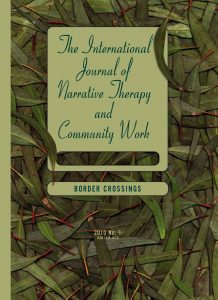 Dear Reader
Dear Reader
G’day and welcome to the first journal issue of 2010. And what a diverse and intriguing collection it is. Every paper is from a different country: South Africa, Australia, UK, Canada, Israel and the USA.
It begins with three narrative practice papers.
Ncazelo Ncube provides new options for those working with children who have experienced abuse. Barbara Wingard provides a way to spark externalising conversations about lateral violence in Aboriginal communities. And Lincoln Simmonds offers reflections and options for practice in relation to narrative approaches to supervision consultations.
These three papers convey a glimpse of the diversity of contexts in which narrative ideas are now being engaged with!
We have entitled this journal issue ‘Border crossings’ because we have deliberately included here three papers that ‘cross’ boundaries or borders between narrative therapy ideas and other approaches to working with individuals and families. Over the years we have received many requests for papers that explore how narrative ideas can be used in conjunction with, or alongside, other ways of working.
This ‘border crossing’ section begins with an interview with Daniel Bogue about family group conferencing which is entitled: ‘Reversing the trend: Families resolving and responding to their own problems of living’. There seems a considerable overlap in relation to the principles of practice of family group conferencing and narrative ideas. We’re delighted to open conversations about these links in this issue.
The second paper, from Razi Shacher, is entitled: ‘Combining relaxation and guided imagery with narrative practices in therapy with an incest survivor’. As the title suggests, this paper explores how the author has used guided imagery alongside narrative practices.
And finally, psychiatrist SuEllen Hamkins discusses ways of bringing narrative practices to psychopharmacology. This is a follow-up to her very popular article which we published some years ago: ‘Introducing narrative psychiatry: Narrative approaches to initial psychiatric consultations’.
These are three significant ‘border crossings’. What can be learned from such situations? We will very much look forward to your comments and reflections about them.
Warm regards,
Cheryl White

 Dear Reader
Dear Reader